 |
|
Albas |
OUT OF THE MISTS OF THE PAST INTO THE MISTS OF THE PRESENT by
Brent C. Dickerson (part 2) A quarter of a century passes. La Quintinye, in his 1695 Instruction pour les Jardins, again mentions a pluralized 'Monthly Rose', under their French name. Here is what he has to say about "les roses de tous les mois," "a sort of red musk rose bearing its flowers in clusters," with its description of the particular cultural method necessary to make the plant bloom "over eight months." He writes, "The Tous-les-Mois rose should be sited in good [bel] air, in full sun, in a sweet and rich soil in order to bear every month; and when the first bloom is over, one cuts them back to the node below where the aforementioned flowers were; doing so after each flowering, you have them over eight months from the first [bloom] up until about [the feast of] Our Lady in December." Eleven years later, Louis Liger d'Auxerre gives us some more information; I quote the 1706 translation by Francis Gentil (The Compleat Florist): "The Every Month Rose is likewise called, the Italian double and perpetual Rose. 'Tis called, Rosa Omnium Calendarum, because being often cut, it produces several buds in clusters, which growing by little and little, yield Flowers that we gather a Second time: and so it goes on successively all the Year round. To make it yield Flowers every Month, or at least for the greatest part of the Year, you must prune it Three or Four times. The first operation of this kind in November, when you ought to cut it almost close to the Ground, to make it sprout a new; for it's commonly those new Shoots that bear the greatest Plenty of Flowers. Before you perform this Operation, I presume you have had the Precaution of furnishing this Rose-Bush with all the Conveniencies that it naturally demands, that is, a Place exposed to the Sun, a good gravelly Earth in the Boxes, if 'tis cultivated so, or a Ring fill'd with such Earth in open Ground. For if these its natural Demands be not duly Answer'd, 'twill yield flowers only once a Year, like the other species. Immediately after this second Lopping, take care to bare it all round the Root, whether in Boxes or open Earth, in order to substitute new Earth in the Room of what was there before, adding to it a sort of Mold half spent; and thereupon to water it out of Hand. The Radical Humour, which it stands in need of, for a Fertility in Flowers, must be fed by frequent watering; for without that Aid, we find sensibly that the Order of Nature is chang'd, and this sort of Rose Tree gives, instead of Flowers, nothing but Leaves and Branches. Experience has given us to know, that the true Way to make it produce a great quantity of Flowers all the Summer round, is as soon as it begins to bud, to strip it of all its Buds, before they blow. When the first Flowers are gone, cut the Branches under the Knot where the Flower did stick; and repeat the same Operation every fall of the Flowers; by this means, you'll gain the Pleasure of seeing your Trees Flower Eight Months in the Year. Take notice that every time you design to lop, or prune, you must discontinue your watering for Fifteen [days] before. This Rosa Omnium Calendarum, is apt to suffer by Cold; to screen it from which, we cover it with Panniers or large Straw, if it stands in open Ground, or convey it to a Green-House, or some other Place of Shelter, if it stands in a Case. If we did not take this Precaution, it would afford us no young fresh Roots. One way to make this Species bear many Roses every Month, is to bow the Branches that we make fast to a Palisade or to Sticks thrust into the Ground, if 'tis planted in Cases. We propagate it by Layers, as well as Slips taken from the Branches cut in Autumn, and stuck in the Ground, taking care not to let them stand above Two Inches above Ground. This shrub being of a Nature that readily takes Root this way, we may readily guess that 'tis easie to perpetuate its Species: These Operations we perform in October or November." Of description, Liger gives us about as much as La Quintinye had: "The Monthly Roses are a Species of the Damask Roses, of a Red Colour, which bear their Flowers in Knots." Comparing La Quintinye and Liger, note that "Musk" and "Damask" were, at the time, considered synonymous, at least partially, by some. In Philip Miller's 1725 Gardener's and Florist's Dictionary, he refers to the "Monthly Rosa omnium Calendarum, or Italian double everlasting Rose," and gives us a new variety as well as some observations: "Monthly and Cluster Monthly planted against [a] warm wall begin to bloom end of March or beginning of April, and continue blowing for almost three Months; and if after they have done blowing you prune off the Tops of the Branches, you may expect them to blow again in Autumn, and continue blowing almost till Christmas, if the weather be open." By his 1731 edition, he lists a 'Striped Monthly'. Meantime, Robert Furber, in his 1730 Twelve Months of Flowers, gives us, in September, the 'White Monthly'.
Weston (1770, 1775) tells us of five monthly roses: Single Red, Blush, Red, White, and Striped. The "Single Red" may be 'Portlandica', which, as we see, appeared about this time. We turn from Weston's barren name-lists to Abbe Le Berriays' Traite des Jardins of 1789--one hears the French Revolution starting in the background, but the book was published "avec Approbation & Privilege du Roi"--and we see some welcome words of description: "The Rosier des quatre saisons, or de tous les mois, which blooms nearly the whole year. It rarely exceeds three feet in height. There's a single purple, a double flesh-colored, and a white," fairly well reflecting the array in Weston's listing, missing only the striped variety if we understand Le Berriays as assuming we already know about the Type sort, the plain Red of Weston. In 1791, Fillassier in his Dictionnaire repeats Le Berriays' height for the plants--three feet--adding, "Its flower, a beautiful red, while double is less so than that of the Centifolia; but its perfume is more intense,' then listing the flesh, white, and pale varieties. Abbe Rozier, in his 1793 Cours Complet d'Agriculture, calls it a variety of Rosa gallica, but gives no description; he does mention that, without extra efforts, "it normally will only bloom one time a year; however, left to itself, it blooms in the Spring and Fall if the specimen undergoes a great dry-spell inbetween; this is what I have observed several times in Languedoc, especially with roses of this sort, planted in meager conditions. Too-great heat suspends their growth; it renews in October." (Part 3)
'Monthly Rose' ('Monats Rose', 'Omnium Calendarum'): "With longly oval, bristly, ovaries and flower stems, less lacinated sepals, wool-like anthers of the length of the stamens, bristly and prickly peduncles, leaves simply dentate, lanate beneath. The flower nearly has the color of the Centifolia, only a little lighter, and doesn't have the rounded form in maturity, but is more expanded. It is full, but there are still stamens. The anthers are as long as the stamens, and hairy. The flowers come both singly and in clusters at the tip of the canes. They start blooming at the beginning of May and can continue for three months. If you prune out the bloomed-out stems, it will continue blooming until the end of Fall. The sepals have pedicellate glands and a foliaceous tip. They are less lacinate, and have occasional appendages on the edges. The ovary is elongate oval round as a fruit, extenuating into the stem such that the only way one can note the point of transition is by the color. The flower-stems are shorter than those of the Centifolia, and have, like the ovaries, fine bristles and thorns. The leaf-stems have very brown glands tipping white bristles, and, beneath, have isolated, sharp, slightly hooked prickles. The bases of the leaves are slender, short, and have fine fringed hairs. The small tips of the leaves are turned sideways. The leaves are almost as big as those of the Centifolia, but thinner, and end in a point. They are mostly simply toothed. Only the ones tipping the sepal sometimes are doubly serrate. The dentations are large, smooth, not distinct, and surrounded along the edges with white hairs which project from the base. The upper surface is more grass-green than with the Centifolia, which is of a lighter green. The under part is a whiter green than with the Centifolia, which has only a dull-white light green. The teeth are also more angled forward and pointy than with the Centifolia, which has larger, more distinct ones. The stem is much branched and has fairly strong and bent thorns, and is also covered with many small prickles. The shoots are of a nice light green, and have small crooked--not straight--prickles, which are found under the base of the leaf-stem. They are also only occasional, coming two or three smaller ones together, or only the bases of the thorns. By the way, it is different than the Straus Month Rose, below, mostly in the fact that, among other things, the Straus Month Rose is thornier on the shoots and is more densely covered with thorns . . . " 'Couleur de Chair' ('Rosa Calendarum Carnea', 'Rotliche Monatsrose'): "This is a bit paler than the common one." 'White Monthly' ('Rosa Calendarum Alba', 'Weisse Monatsrose'). [No description by Rossig] 'Striped Monthly' ('Rosa Calendarum variegata', 'Gestreifte Monatsrose'): " . . . Miller regards it as his modified Rosa Damascena; this however is contradicted by the form of the flower and ovary." 'Cluster Monthly' ('Rosa Calendarum corymbosa', 'Bouquet Monatsrose'): "This rose is regarded by Mr. Borthausen as a variety of the Monthly Rose, and gives as the difference between them that its flowers come 6-8 blossoms in the cluster (Bouquet). Since he doesn't give any other description of it, I put the flower in Leipzig's flower garden for observation. I noted that the two flowers are different in many other points, so I regard this flower as its own variety."
'English White Full Monthly Rose' ('Rosa alba Calendarum plena', 'Englische weisse gefullte Monatsrose'): "With lacinate sepals, smooth oval ovaries, thin bristly flower stems, lanceolate leaves, smooth peduncles and pedicels. The flower is full and white, but it doesn't compare at all with the Scottish white Centifolia. At first, in the very center it has more of a liver [!]-color. It spreads out flatter, and arcs only a bit at the top. The flower as a whole has a white appearance. The sepals come all the way down to the ovaries; they are lacinate, the two opposite ones quadruply, the other two doubly, with one entire. They are thin and pointed like a pyramid, without extended tips. They have on their surface fine hairs and glands, and are fringed along the sides; as the flower blooms, they bend backwards. The ovary is dark green, oval, smooth, and glossy, only at the base; there are some bristles on the stem, and towards the tip it narrows into a neck. The flower-stems have no bracts, and are thin and bristly, with small glands. The bristles, which are red, are slightly bent. The upper surface of the leaves are an almost dirty green, and matte. Beneath, they are lighter and the main nerves are noticeable; they are long, oval towards the tip and thinner towards the base. The long sharp dentations are slightly bent forwards. At the tip, they are longer and more lanceolate. The shoots and leaf stems are smooth and have only a few thorns on the lower portions. The stipules on the leaf-stems are wider at the tip, where they reach the lowest pair of leaflets. They have short teeth, though very dentate, and have white and almost unnoticeable hairs. Stems and twigs are nearly thornless, only on the suckers or on the leaf stems can one find some prickles. Even at the base of the stem, which is greener than brown, there are few thorns." Thus, Rossig.
In 1805, Andrews contributes his unmistakable prose; here he is, first on the original 'Monthly Rose', which he calls 'Rosa menstrua, var. flore racemoso/Monthly Rose, Cluster-flowered Variety': "Rose with oblong seed buds, often flowering clustered, sweet-scented, the peduncles and pedicels are hispid and glandular; the prickles of the branches are scattered and straight, the leaflets are of an oblong form, and villous beneath. This cluster-flowered Variety is undoubtedly the most attractive of that species of Rose denominated Monthly. To its fine abundant and frequent bloom is attached a fragrance of unequivocal sweetness, for which it is much esteemed. It bears so great a resemblance to the Damask Rose [echoing Rea!], that we are strongly induced to regard it as a continuation of that species, and have but little doubt, if the flowers were dried and analysed, they would be found to contain the same medicinal virtues. The title of Monthly is certainly a term of latitude with regard to its flowering; for, in the literal sense, it should imply a perpetually blooming Rose, which undoubtedly a Rose must be that blossoms every month; but this is by no means the case with the present species, although in mild seasons it may be found in bloom in December or January; which gives it a decided superiority over many of the summer species. Our figure was taken from a fine blooming specimen in the month of September, at the nursery of Messrs. Whittley and Brames, Old Brompton."
There
have been |
|

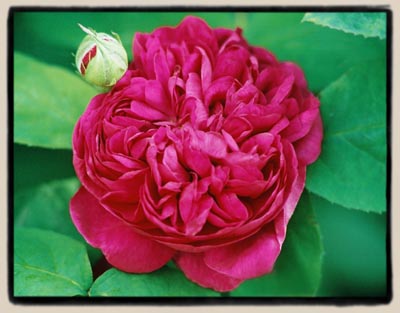
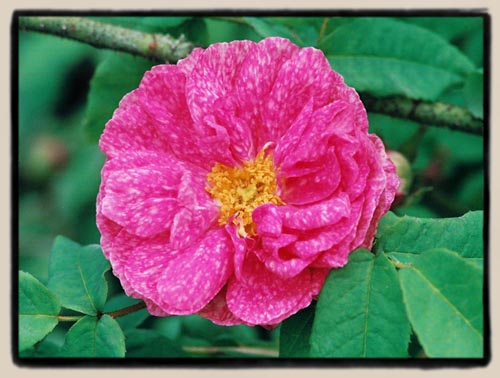 At
right:
At
right: 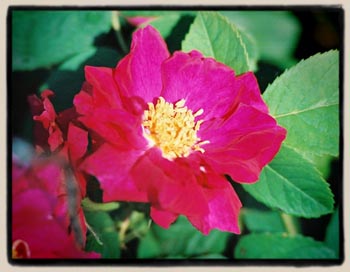 At
left: 'Portlandica'
At
left: 'Portlandica'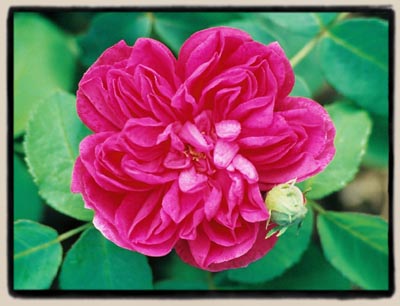 At
right: 'Portland from Glendora'
At
right: 'Portland from Glendora'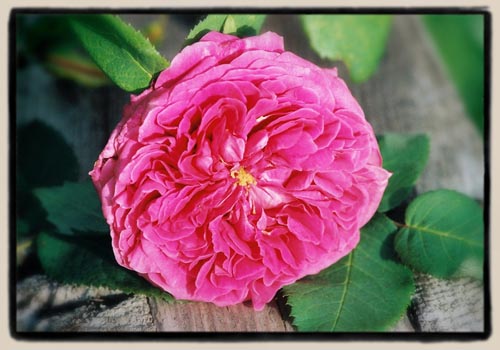 At
left: 'Yolande d'Aragon'
At
left: 'Yolande d'Aragon'